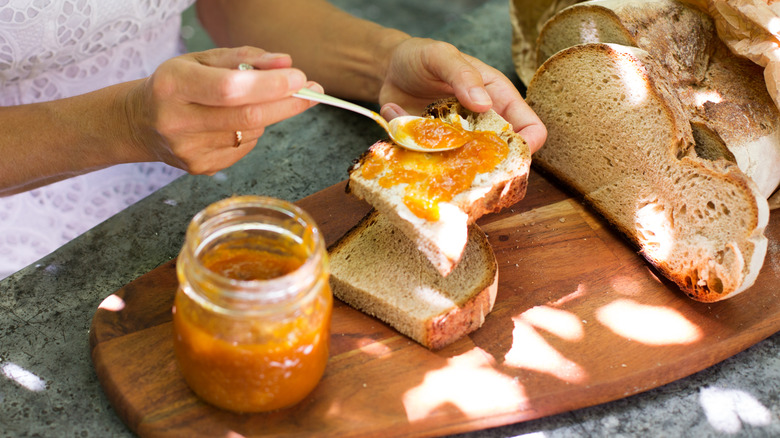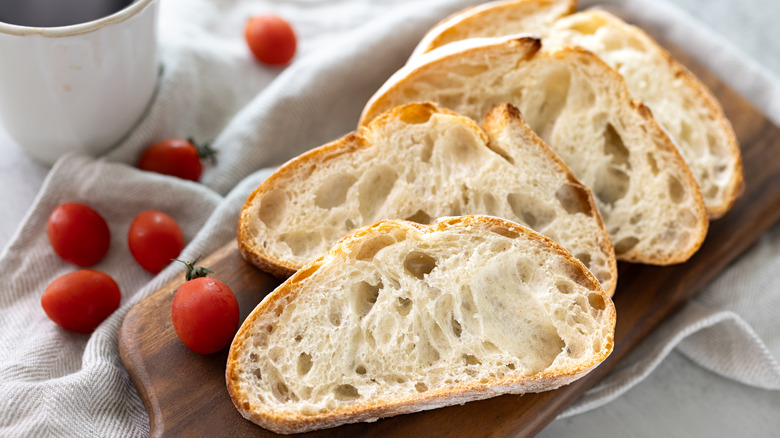Why There Are So Many Holes In Your Homemade Bread
If you've sliced into a freshly baked loaf of bread to find the interior is riddled with holes, you may be wondering what could have gone wrong. Are mice living inside your oven, or did you mess up the recipe? To find out more, we talked to Sheena Otto, executive baker at Sheena's Cocina.
"Some artisan sourdough loaves are aiming for large holes," Otto told The Takeout. "But if you're making a sandwich bread, you typically want a tighter crumb so that the sandwich filling doesn't get all over your hands."
Assuming you weren't trying for Instagrammable bread holes, what could be going on here? "If you are using a recipe that is supposed to call for a tighter crumb and your loaf is full of holes, then yes, something went wrong along the way," Otto continued. "Usually in the mixing or shaping of the loaf." The only way to salvage the imperfect loaf may be to pretend that the holes were deliberate (just call it rustic and let the applause roll in). Otto did, however, offer some advice for how to fix the problem next time you bake.
How to keep your bread relatively hole-free
If you're baking a simple white bread loaf and want it to come out with a smoother surface than the moon, Otto's first piece of advice is sure to help. "It seems counter-intuitive, but kneading the bread more will result in a tighter, more uniform crumb and therefore fewer holes." You'll also need to make sure your recipe is a low-hydration one. A low-hydration dough is technically any dough with 60% or less hydration (i.e. water). The percentage expresses the proportion of water to flour, so 60% hydration would mean three parts water to five parts flour. High-hydration breads tend to have bigger holes.
Otto advises using a higher-protein flour (bread flour works well, as its name indicates) and using a machine for kneading. This could be a stand mixer with a dough hook or it could be a bread machine. As for shaping the dough: "Make sure you knock out all of the larger gas bubbles that might be on the surface of the dough," she says. "This will all lead to a uniform, tighter crumb structure."
What breads are supposed to have holes?
"High-hydration, leaner breads made without milk, eggs, butter, or oil tend to have a more irregular crumb structure than lower hydration, enriched doughs," Otto continued. "The high hydration lends to a more pliable dough." 80% is often considered the cut-off point for high-hydration dough. Some of the higher-hydration breads include ciabatta, focaccia, and glass bread (aka pan de cristal). With 100% hydration, glass bread's dough looks and feels more like a batter until it starts to rise. When baked, it's known for a super-crispy crust and an interior holier than Pope Leo's always-clean plate. (We're not sure if the pontiff's ever tried pan de cristal, but he'd be sure to eat the whole slice if one was offered.)
Otto also spoke on the subject of sourdough bread, a popular project with pandemic bakers that's remained trendy today. Sourdough hydration can range from 56% (which is considered low) all the way up to 83%. Still, no matter the hydration level, sourdough loaves tend to be full of holes because, as Otto explained, "The sourdough begins acting on the gluten strands in such a way to weaken them just enough so that some break, but some stay intact, leading to an irregular crumb structure inside."


